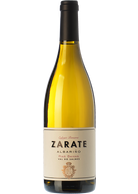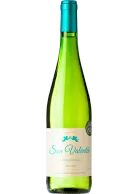White wine
White wine has a prominent role to play on everyone’s dining table. The versatility, flavours and immediate pleasure that it offers us have made it an essential option in any restaurant or for whatever celebratory occasion. Getting to know it better will help us to enjoy it to the full.







All there is to know about white wine
How is white wine made?
White wine is mainly produced from white grapes, although it’s also possible to make it from red grapes by limiting contact of the must with the skins to the minimum, so that they don’t release their colour. However, the most usual process involves pressing the destemmed grapes (without any stalks) and separating the must from the paste immediately in order for fermentation to occur afterwards in the absence of skins. The low tannicity (dryness) resulting from a minimal infusion of the skins leads to a more pleasant and versatile wine style than found with a red and a softer feel. In addition, the majority of white wines, especially the warm climate ones, don’t undergo malolactic fermentation, which consequently enables them to retain all their natural freshness. Another style of white worth mentioning is the so-called ‘orange’ wine, showing up on the label as brisado or brisat, and in the production process the must does ferment with the skins, as though it were a red, generating a more structured and drier wine.
Ageing
Most white wines aren't aged in barrel. Their vinification usually takes place in stainless steel tanks which don’t impart any aromas or texture to the wine. However, there are a fair number of wines which do undergo an ageing process. This style of wine tends to be more weighty and spicy, thanks to micro-oxygenation made possible by the barrels and to the aromas given off from inside by the toasted wood. Another technique which has become increasingly more popular in recent years is ageing in concrete or clay earthenware, as both materials allow the wines to breathe during their ageing process, but which bestow much subtler aromas than oak.
White grapes
The number of white grape varieties destined for winemaking is almost endless, although in reality, the majority of quality white wines are produced from only a few varietals. Chardonnay, Sauvignon Blanc, Riesling, Chenin Blanc, Gewürztraminer, Muscat, Pinot Gris and Viognier are some of the key names known worldwide, but it’s important not to forget other fine grapes such as the Garnacha Blanca (White Grenache), Grüner Veltliner or Sémillon. These include varieties which are characterised by their aroma, but others too whose personality is built upon their captivating flavour and feel.
Wine-growing regions
The huge variety of white grapes and their innumerable aromas, flavours and sensations multiply further when we add to the equation the countless plots of land dotted around the world. The French Chardonnay and German Riesling are probably the world’s greatest white wines, but following close behind are many other grapes which express themselves in very different ways in each individual region. Indeed, a white wine grown in a warm climate will have more body and more developed aromas or flavours, whereas those coming from a cool climate will be fresher and more fragrant. We should obviously try and taste Old World wines (European), but it wouldn’t be fair to forget the magnificent ones produced in the New World. California, Australia and New Zealand, to mention just some examples, produce world-class wines.
White wine styles and their pairings
White wine offers us a huge range of possibilities when it comes to finding it some company on the dinner table. The lightest and fruitiest wines, non-barrel aged and with a moderate alcohol level, are ideal for similarly light and mildly-flavoured dishes, such as appetizers and salads. As the dish increases in intensity, the same should happen with the wine, and we’re not simply thinking of fish, but also of white meats, being one of the foods that pairs best with white wine. Chicken served in a spicy, creamy sauce, or oven-baked fish with vegetables, can work wonderfully well with barrel-aged whites, whose body and flavour will match the dish’s strong and savoury nature. Not forgetting the perfect interaction between white wine and a large number of cheeses, with just a few examples: fresh cheese, goat’s cheese, soft cheese such as Camembert, or a washed rind cheese like Munster from Alsace.
















